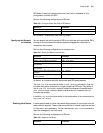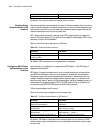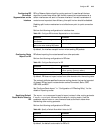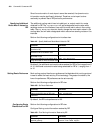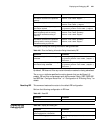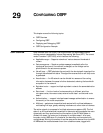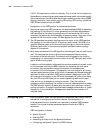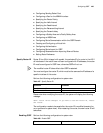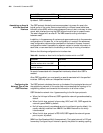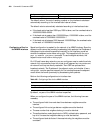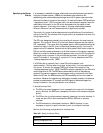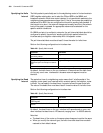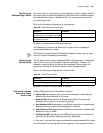
424 CHAPTER 29: CONFIGURING OSPF
0.0.0.0. All areas must be continuous logically. Thus, a virtual link is introduced to
the backbone to ensure that physically separated areas are still connected logically.
The router between the ASs is called autonomous system boundary router (ASBR).
Routing information, such as static routing, RIP routing, BGP routing, outside the
OSPF AS can be learned from the ASBR.
Computation of the OSPF protocol is summarized as follows:
1 Every router supporting OSPF maintains a link state database (LSDB) for describing
the topology of the entire AS. A router generates the Link State Advertisement
(LSA) according to the network topology around it and sends the LSA to other
routers on the network by the transmission of protocol packets. Thus, every router
receives the LSA from other routers. All LSAs together forms the LSDB.
2 The LSA describes the network topology around a router, so the LSDB describes
the topology of the whole network. A router can easily convert the LSDB into a
weighted directed graph, which shows the real topology of the whole network.
Obviously, each router in the autonomous system receives the same topology
diagram of the network.
3 Each router calculates with the SPF algorithm a shortest path tree with itself as the
root. This tree gives the routes to all autonomous systems. External routing
information is the leaf sub-node. The external route is flagged by the router by
broadcasting it to record additional information for the AS. Obviously, each router
gets a different routing table.
In addition, multiple adjacent relationship lists must be created so that each router
on the broadcast network and NBMA network can broadcast the local status
information (such as available interface information and reachable peer
information) to the whole system. Consequently, the route change of any router
may be transmitted many times, which is both unnecessary and wastes bandwidth
resources. To solve this problem, OSPF protocol selects a designated router (DR).
All routers send information to the DR, which broadcasts the network link status.
Two non-DR routers (DR Other) do not create neighboring relations with each
other and do not exchange any routing information. Then the number of
neighboring relations between the routers on the multi-address network is greatly
The OSPF protocol supports IP subnet and the marking and receiving of external
routing information. It supports interface-based message authentication to insure
the security of route calculation. Messages are transmitted and received in IP
multicast mode.
Configuring OSPF In all configuration tasks, the OSPF-specified interface and area number must be
defined first to configure other function features. The configuration of
interface-related function features is not restricted by whether OSPF has been
enabled. The original interface parameters become invalid after OSPF is
terminated.
OSPF configuration includes:
■ Specify Router ID
■ Enabling OSPF
■ Associating an Area-id with the Specified Interface
■ Configuring the Network Type of the OSPF Interface




